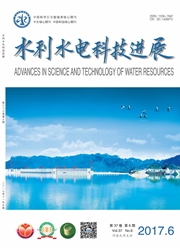

 中文摘要:
中文摘要:
为开展水流交汇区污染物浓度分布研究,进行水流交汇区水动力学特性的数值模拟,建立适用于水流交汇区的水气两相流数学模型。模型采用Weber试验数据进行验证,验证结果表明模型模拟的自由水面、流场与试验结果吻合较好。针对交汇区浓度分布试验的研究需要,模拟分析了不同交汇角、流量比和动量比对交汇区水动力学特性的影响。研究结果表明:分离区的范围随交汇角、流量比和动量比的减小而逐渐缩小直至分离区消失,交汇角、流量比和动量比越小,交汇口上游水位的壅高及分离区内水位的下降程度越不明显。
 英文摘要:
英文摘要:
In order to investigate the characteristics of the pollutant concentration distribution at open-channel confluences, a twophase flow model was developed to reveal the hydrodynamic characteristics of confluence flows. The model was verified with experimental data from Webber. The numerical results were found to agree with the measured free surface profiles and the flow fields. The effects of the junction angle and the discharge ratio on the hydrodynamic characteristics of confluence zone were numerically investigated. The results indicate that the size of the separation zone decreases with decreasing junction angle and discharge ratio and momentum ratio until the separation zone disappears. The smaller the junction angle and the discharge ratio and momentum ratio are, the less evident the degree of the water-level rise upstream of the confluence zone and the water-level decline in the separation zone.
 同期刊论文项目
同期刊论文项目
 同项目期刊论文
同项目期刊论文
 A laterally averaged two-dimensional simulation of unsteady supersaturated total dissolved gas in de
A laterally averaged two-dimensional simulation of unsteady supersaturated total dissolved gas in de Comparison of Supersaturated Total Dissolved Gas Dissipation with Dissolved Oxygen Dissipation and R
Comparison of Supersaturated Total Dissolved Gas Dissipation with Dissolved Oxygen Dissipation and R A hydraulics-based analytical method for artificial water replenishment in wetlands by reservoir ope
A hydraulics-based analytical method for artificial water replenishment in wetlands by reservoir ope Eco-environmentally friendly operational regulation: an effective strategy to diminish the TDG super
Eco-environmentally friendly operational regulation: an effective strategy to diminish the TDG super 期刊信息
期刊信息
